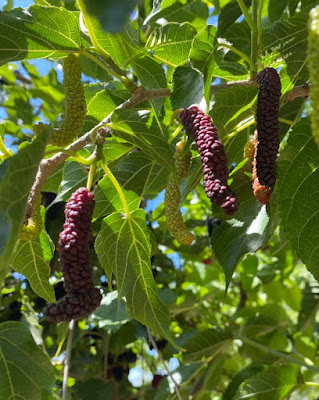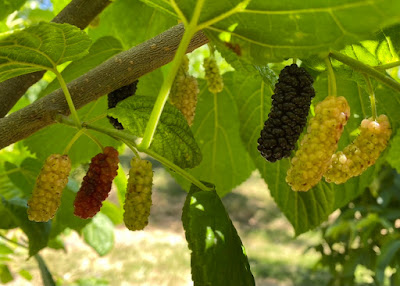This year we started picking mulberries already in April. The first cultivar to produce was Himalayan DMOR9, the longest berry in the picture below. Here I have (left to right): Pakistan, Oscar, Maple Leaf, Himalayan DMOR9, Pakistan White, Big leaf FL
Himalayan DMOR9 is an excellent mulberry with very high sugar and some acid, a few more pictures below
The tree is large and vigorous. The cuttings do not root and the propagation is by grafting mostly. I didn’t try the air layering yet, this might work too. The leaves are slightly lobed.
Pakistan White (Saharanpur Local, Australian Green) produces extremely sweet long white mulberries. No acid in these fruits and they can be consumed even when not fully ripe. The tree is very vigorous. The cuttings do not root and should be grafted.
Oscar is a relatively common cultivar with sweet- sour fruits. They need to be fully ripe to be enjoyable. Just a standard good dark fruit without anything special in it. Large tree that needs pruning every season. Oscar dormant cuttings can be rooted. Below are the Oscar fruits along a few Pakistan white fruits.
In two images below I show how Oscar compares to Maple Leaf mulberry fruits. Oscar is on the left in both images.
Maple Leaf is an excellent mulberry and deserves a better distribution. The fruits are long, some can be as long as the smaller Pakistan mulberries. Very sweet with a little acid. The tree is large. It seems it can be rooted from dormant cuttings. The images are above along with Oscar fruits. In the below image, Maple Leaf is the rightmost fruit. Left to right here are Himalayan DMOR9, Pakistan, Oscar, and Maple Leaf.
Buluklu mulberry just started ripening in the end of May. The large tree produces a lot of sweet very juicy fruit without any acidity. I like them very much. This type of the fruit is very common in Central Asia and Turkey.
In the image below, all short white fruits are Buluklu.
Big Leaf FL is the code name for the mulberry that came nameless from Florida. The fruits are relatively large, black, sweet-sour and need to be completely ripe to be enjoyable. The leaves are very large on this tree. In the image above, these fruits are on top of the Buluklu fruits in the container on the right.
More pictures below.
Pakistan is a very good large fruit with a balance of sweet and sour, more on the sweet side. It’s not as intense as the Himalayan DMOR9 however. Here is how it compares to Illinois Everbearing in the picture below. This is a large tree, needs yearly pruning. The dormant cuttings can be rooted.
Illinois Everbearing is
just starting to ripen the very first fruits. It’s a later ripening cultivar. The fruits are small, sweet-sour and need to be fully ripe to be enjoyable. The fruits are in the picture above on the right. The tree is large, the cuttings do not root and should be grafted.
Black Prince doesn’t normally fruit in May, but I have a grafted tree in a 10 gallon pot by the Southern wall in my backyard and it produces now. The fruits on my in ground tree are not ready yet. These are excellent, very sweet with a little acid. The fruit size from this potted tree is smaller than the ones from the in ground tree.
The fruits have a lighter middle core.
I should move this tree to a large pot of I want to keep it in my yard. Here is the tree:
Black Prince trees are large, and it seems that the cuttings can be rooted.
Material availability. Many of these can be found as cuttings at the winter exchanges organized by the
CRFG chapters. If I have material for sale, I post it at
reallygoodplants.com









































